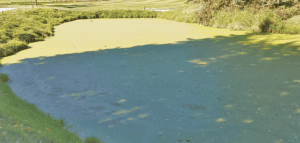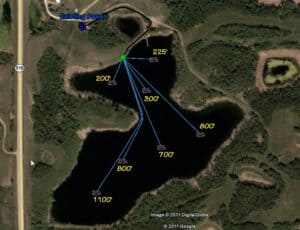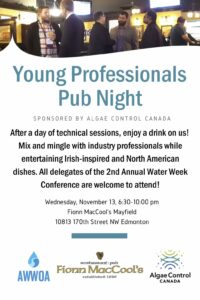
EUTROPHICATION
Eutrophication is the ecosystem response to the addition of artificial or natural substances, mainly phosphates,

Over the last decade we have had the opportunity, through our sister company Smoky Trout Farm Ltd, to work with the Red Deer Fish and Game Club to help them develop an amazing fishery in central Alberta. This a a great example of how properly designed aeration and in-lake treatments improve surface water quality. The blog post below was originally posted on the Smoky Trout Farm website.
by Bobbi Menard

Aerial of RDFGA’s West Lake
With some planning and patience, the Red Deer Fish and Game Association (RDFGA) has achieved an excellent fishery in their West Lake of the club property, with diverse fishing opportunities for their members. In addition to a vibrant trout fishery in their West Lake pond, the RDFGA has built an additional children’s fishing pond, disability access, senior’s events and promoted the cause of responsible stewardship. The RDFGA began their journey to meet their members’ desire to fish more than a decade ago. Their experience shows how using science and working with nature over time can produce excellent outcomes.
West Lake is one of about a dozen surface water bodies (from ponds to sloughs to lakes) on the RDFGA’s 320 acres 18 km east of Red Deer. West Lake is about 20 acres in size with an average depth of 19-20 feet. It’s shallow enough for efficient aeration, but too shallow to easily over-winter rainbow trout.
The challenge of the shallowness is compounded by the fact that West Lake is a “very productive” lake, explains Jim Allan, a volunteer with the RDFGA and a retired scientist and Alberta government fisheries employee. In this case “productive” means West Lake has an over-abundance of organics and materials that need to break down in the water body.
West Lake’s nutrient load was the long-standing challenge that had to be met in order to improve the environment to sustain a fishery.
In the late 1990s, prior to Allan joining the club, windmills had been installed and the resulting aeration supported a rainbow trout stocking program for about 3 years. But the bottom muck layer of the lake and the intense anaerobic conditions overwhelmed both the windmill-produced aeration and the trout program.
In 2008 the club decided to explore the possibility of another trout stocking program. They asked Allan, as a member, to volunteer and lead a feasibility study. “It’s disheartening to see dead fish,” says Allan. “We wanted to be certain that if it was possible to do something and start stocking again, it would be successful.”
Following the feasibility study, the technical quoting process and review, combined with the good will of the membership, the RDFGA installed aeration, designed and supplied by Smoky Trout Farm, which also provided installation assistance, in the fall of 2012. The technical data defined the scope of the aeration required, so the aeration system operated for the winter of 2012/13 to bring up the oxygen saturation in the water.
 Aeration design for West Lake
Aeration design for West Lake
Beginning aeration a season prior to stocking had a vote of confidence from a random phenomenon: an intense first-time gathering of seagulls. “I couldn’t quite figure out what would bring them out, until I realized the amount of biological material aerated from the bottom of the lake was just that large,” recalls Allan with a laugh.
The following spring, the RDFGA stocked West Lake with 3000 rainbow trout from Smoky Trout Farm. RDFGA members had their first great opportunity to fish in almost a decade.
The aeration increased dissolved oxygen levels and basic water structure of West Lake improved sufficiently to sustain fish. And, the aeration had had a noticeable, positive impact on weed growth and specific species of algae. The RDFGA moved to the next portion of their goal: improving water clarity and the all-around lake experience to increase fishing opportunities.
The summer of 2013 was the start of a 3-year program of in-lake treatments utilizing bio-augmentation (adding beneficial bacteria) to West Lake. By 2016, West Lake had achieved “dramatic improvement” in water clarity: in 2013 the estimated clarity was about 1 foot, in 2016 the estimated clarity was about 8 feet.
Since the start of the stocking program, member usage has increased every year. But, community opportunity only begins with fish and water quality. The RDFGA has taken steps to improve experience for anglers of every age and ability.
“Our goal was to provide our membership opportunities to fish with a minimum of regulation,” says Allan. “We’ve achieved that.”
To test the sustainable viability of the fishery, Allan tagged roughly 40 fish a few years ago to track growth rates – an indicator of the health of the fishery. The results showed reasonable to robust rates of growth, but not the sense that West Lake is a “trophy” destination.
“We have a good quantity of reasonably sized rainbow trout,” says Allan. “The club has avid fishermen, some of whom have told us they consider West Lake to be one of the best fisheries in Central Alberta.”
The club’s diverse land base and respectful membership have ensured that the angling pressure on West Lake is well-managed and the approach to create angling opportunities remains sustainable. “Our demand has increased, but it hasn’t been excessive and we still have a lots of opportunities,” says Allan.

Eutrophication is the ecosystem response to the addition of artificial or natural substances, mainly phosphates,

HIGH-SPEED, HIGH-IMPACT CHANGE The water in your pond naturally seeks thermal equilibrium via stratification. Stratification

A properly designed aeration system will initiate a series of visible changes in your pond

We’re proud members of the Alberta Water and Wastewater Operators Association (AWWOA). AWWOA’s fall event for

Algae Control Canada offers comprehensive water management solutions to a diverse array of clients including mines and other heavy industry, municipalities, large agriculture installations, and private pond owners.
Location:
39041 RGE RD 283, Red Deer County, AB T4E 0M2
Phone:
1-888-466-0031
Fax:
1-888-507-9716
Email:
[email protected]
SMOKY TROUT FARM – ALL RIGHTS RESERVED